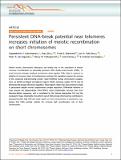Por favor, use este identificador para citar o enlazar a este item:
http://hdl.handle.net/10261/203733COMPARTIR / EXPORTAR:
 SHARE SHARE
 CORE
BASE CORE
BASE
|
|
| Visualizar otros formatos: MARC | Dublin Core | RDF | ORE | MODS | METS | DIDL | DATACITE | |

| Campo DC | Valor | Lengua/Idioma |
|---|---|---|
| dc.contributor.author | Subramanian, Vijayalakshmi V. | - |
| dc.contributor.author | Zhu, Xuan | - |
| dc.contributor.author | Markowitz, Tovah E. | - |
| dc.contributor.author | Vale-Silva, Luis | - |
| dc.contributor.author | San-Segundo, Pedro A. | - |
| dc.contributor.author | Hollingsworth, Nancy M. | - |
| dc.contributor.author | Keeney, Scott | - |
| dc.contributor.author | Hochwagen, Andreas | - |
| dc.date.accessioned | 2020-03-12T11:14:11Z | - |
| dc.date.available | 2020-03-12T11:14:11Z | - |
| dc.date.issued | 2019-02-27 | - |
| dc.identifier | doi: 10.1038/s41467-019-08875-x | - |
| dc.identifier | e-issn: 2041-1723 | - |
| dc.identifier.citation | Nature Communications 10: 970 (2019) | - |
| dc.identifier.uri | http://hdl.handle.net/10261/203733 | - |
| dc.description.abstract | Faithful meiotic chromosome inheritance and fertility rely on the stimulation of meiotic crossover recombination by potentially genotoxic DNA double-strand breaks (DSBs). To avoid excessive damage, feedback mechanisms down-regulate DSBs, likely in response to initiation of crossover repair. In Saccharomyces cerevisiae, this regulation requires the removal of the conserved DSB-promoting protein Hop1/HORMAD during chromosome synapsis. Here, we identify privileged end-adjacent regions (EARs) spanning roughly 100 kb near all telomeres that escape DSB down-regulation. These regions retain Hop1 and continue to break in pachynema despite normal synaptonemal complex deposition. Differential retention of Hop1 requires the disassemblase Pch2/TRIP13, which preferentially removes Hop1 from telomere-distant sequences, and is modulated by the histone deacetylase Sir2 and the nucleoporin Nup2. Importantly, the uniform size of EARs among chromosomes contributes to disproportionately high DSB and repair signals on short chromosomes in pachynema, suggesting that EARs partially underlie the curiously high recombination rate of short chromosomes. | - |
| dc.description.sponsorship | This work was funded in part by grant R01 GM111715 from the NIH and research grant #6-FY16–208 from the March of Dimes Foundation to A.H.; grant R35 GM118092 from the NIH to S.K. and MSKCC Cancer Center Core Grant P30 CA008748; grant R01 GM050717 from the NIH to N.M.H.; grants BFU2015–65417-R from MINECO and CSI084U16 from Junta de Castilla y León in Spain to P.A.S. | - |
| dc.language | eng | - |
| dc.publisher | Nature Publishing Group | - |
| dc.relation | info:eu-repo/grantAgreement/MINECO/Plan Estatal de Investigación Científica y Técnica y de Innovación 2013-2016/BFU2015-65417-R | - |
| dc.relation.isversionof | Publisher's version | - |
| dc.rights | openAccess | - |
| dc.title | Persistent DNA-break potential near telomeres increases initiation of meiotic recombination on short chromosomes | - |
| dc.type | artículo | - |
| dc.identifier.doi | 10.1038/s41467-019-08875-x | - |
| dc.relation.publisherversion | http://dx.doi.org/10.1038/s41467-019-08875-x | - |
| dc.date.updated | 2020-03-12T11:14:11Z | - |
| dc.rights.license | https://creativecommons.org/licenses/by/4.0/ | - |
| dc.contributor.funder | National Institutes of Health (US) | - |
| dc.contributor.funder | March of Dimes Foundation | - |
| dc.contributor.funder | Memorial Sloan Kettering Cancer Center | - |
| dc.contributor.funder | Ministerio de Economía y Competitividad (España) | - |
| dc.contributor.funder | Junta de Castilla y León | - |
| dc.relation.csic | Sí | - |
| dc.identifier.funder | http://dx.doi.org/10.13039/501100003329 | es_ES |
| dc.identifier.funder | http://dx.doi.org/10.13039/100000002 | es_ES |
| dc.identifier.funder | http://dx.doi.org/10.13039/100000912 | es_ES |
| dc.identifier.funder | http://dx.doi.org/10.13039/100007052 | es_ES |
| dc.identifier.funder | http://dx.doi.org/10.13039/501100014180 | es_ES |
| dc.identifier.pmid | 30814509 | - |
| dc.type.coar | http://purl.org/coar/resource_type/c_6501 | es_ES |
| item.openairecristype | http://purl.org/coar/resource_type/c_18cf | - |
| item.openairetype | artículo | - |
| item.grantfulltext | open | - |
| item.fulltext | With Fulltext | - |
| item.cerifentitytype | Publications | - |
| Aparece en las colecciones: | (IBFG) Artículos | |
Ficheros en este ítem:
| Fichero | Descripción | Tamaño | Formato | |
|---|---|---|---|---|
| Persistent DNA-break.pdf | 4,05 MB | Adobe PDF |  Visualizar/Abrir |
CORE Recommender
PubMed Central
Citations
27
checked on 15-may-2024
SCOPUSTM
Citations
31
checked on 10-may-2024
WEB OF SCIENCETM
Citations
42
checked on 27-feb-2024
Page view(s)
171
checked on 19-may-2024
Download(s)
105
checked on 19-may-2024

